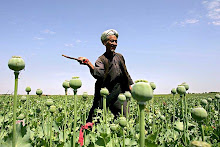View Larger Map
Afghanistan is the largest producer of opium in the world.
According to the United Nations, in 2007, more than 90% of the opium produced in the world came from Afghanistan. Opium cultivation and drug trafficking contribute 60 percent of the national income.
More disturbing is the fact that Taliban uses the drug money to finance its activities.
Major areas of opium cultivation in Afghanistan are the provinces bordering Pakistan and Iran, thus facilitating drug transactions. Opium farmers receive only a fraction of the returns from the drug trade but it still is about ten times higher than returns from wheat cultivation. For the impoverished Afghan farmers, it is an enticement hard to resist.
Being the most lucrative source of income in Afghanistan, opium trade has many stake-holders. Opium trade flourishes in regions which the Taliban now control. Ironically, it was Taliban which had initiated the world’s most successful drug eradication programme less than a decade ago when it declared opium cultivation as un-Islamic. The Taliban finance their terrorist activities with the returns from their drug trade.
Besides the Taliban, opium trade also thrives in regions controlled by former warlords. Historically, opium trade was used by them to finance the purchase of weapons. During the war on Afghanistan, United States used these warlords for the overthrow of the Taliban. Now a reluctant partnership exists between the warlords and the US. The US needs them in its hunt for Taliban. Thus, its ability to control the drug trade is greatly hampered.
Then there are government officials who turn a blind eye to the drug trade in exchange for bribes. This makes the implementation of anti-drug initiatives difficult at the grassroots level. There have been numerous reports of the Afghan police selectively destroying the crops of those farmers who did not or could not afford to pay bribes.
To top it all, there is the weak Hamid Karzai government which controls only parts of the country. There are also allegations that the government itself protects opium cultivation.
Opium cultivation flourishes in regions where political instability exists and economic avenues are constrained. Afghanistan is a good example. The most effective way to control drug trade is to check it at its source. To do so it is essential to provide opium cultivators with economically viable alternatives to growing opium.









No comments:
Post a Comment